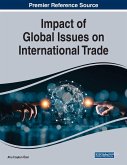Global Backlash
Citizen Initiatives for a Just World Economy
Herausgeber: Broad, Robin
Global Backlash
Citizen Initiatives for a Just World Economy
Herausgeber: Broad, Robin
- Broschiertes Buch
- Merkliste
- Auf die Merkliste
- Bewerten Bewerten
- Teilen
- Produkt teilen
- Produkterinnerung
- Produkterinnerung
Global Backlash is the first book to move beyond the monolithic portrayal of the globalization protests that have escalated since Seattle and are not likely to abate soon. With trenchant analysis and dozens of primary documents from a variety of popular and uncommon sources, Robin Broad explores proposals and initiatives coming from the backlash to answer the question, "But what do they want?" A range of sophisticated propositions and a vibrant debate among segments of the backlash emerge. Highly readable and analytically powerful, this book is vital to understanding the most potent protest movement of our times.…mehr
Andere Kunden interessierten sich auch für
![Illicit Global Economy and State Power Illicit Global Economy and State Power]() Illicit Global Economy and State Power56,99 €
Illicit Global Economy and State Power56,99 €![Global Sport Sponsorship Global Sport Sponsorship]() Global Sport Sponsorship47,99 €
Global Sport Sponsorship47,99 €![Global Comparative Management Global Comparative Management]() Ralph B. EdfeltGlobal Comparative Management128,99 €
Ralph B. EdfeltGlobal Comparative Management128,99 €![Impact of Global Issues on International Trade Impact of Global Issues on International Trade]() Impact of Global Issues on International Trade169,99 €
Impact of Global Issues on International Trade169,99 €![Global Business Intelligence Global Business Intelligence]() Global Business Intelligence56,99 €
Global Business Intelligence56,99 €![Turkey and the Global Economy Turkey and the Global Economy]() Turkey and the Global Economy47,99 €
Turkey and the Global Economy47,99 €![Global Universities and Urban Development Global Universities and Urban Development]() Wim WiewelGlobal Universities and Urban Development56,99 €
Wim WiewelGlobal Universities and Urban Development56,99 €-
-
-
Global Backlash is the first book to move beyond the monolithic portrayal of the globalization protests that have escalated since Seattle and are not likely to abate soon. With trenchant analysis and dozens of primary documents from a variety of popular and uncommon sources, Robin Broad explores proposals and initiatives coming from the backlash to answer the question, "But what do they want?" A range of sophisticated propositions and a vibrant debate among segments of the backlash emerge. Highly readable and analytically powerful, this book is vital to understanding the most potent protest movement of our times.
Produktdetails
- Produktdetails
- Verlag: Rowman & Littlefield Publishers
- Seitenzahl: 368
- Erscheinungstermin: 20. März 2002
- Englisch
- Abmessung: 254mm x 178mm x 20mm
- Gewicht: 692g
- ISBN-13: 9780742510340
- ISBN-10: 0742510344
- Artikelnr.: 22256738
- Herstellerkennzeichnung
- Libri GmbH
- Europaallee 1
- 36244 Bad Hersfeld
- gpsr@libri.de
- Verlag: Rowman & Littlefield Publishers
- Seitenzahl: 368
- Erscheinungstermin: 20. März 2002
- Englisch
- Abmessung: 254mm x 178mm x 20mm
- Gewicht: 692g
- ISBN-13: 9780742510340
- ISBN-10: 0742510344
- Artikelnr.: 22256738
- Herstellerkennzeichnung
- Libri GmbH
- Europaallee 1
- 36244 Bad Hersfeld
- gpsr@libri.de
Robin Broad is associate professor of international development at American University in Washington, D.C.
Chapter 1 Acknowledgments
Chapter 2 List of Acronyms
Chapter 3 Introduction: Of Magenta Hair, Nose Rings, and Naïveté
Part 4 Part I The Clash of Visions
Chapter 5 Introduction
Chapter 6 1.1 Globaphobia: Confronting Fears about Open Trade
Chapter 7 1.2 Address to WTO Ministerial Meeting
Chapter 8 1.3 Report of the International Financial Institution Advisory
Commission
Chapter 9 1.4 Free Trade Is Not Free
Chapter 10 1.5 Globalism on the Ropes
Chapter 11 1.6 Alternatives to Economic Globalization
Chapter 12 1.7 The New Internationalism
Chapter 13 1.8 General Principles and Gender
Chapter 14 1.9 The Death of the Washington Consensus?
Chapter 15 For Further Reading
Part 16 Part II The Historical Context
Chapter 17 Introduction
Chapter 18 2.1 How Europe Underdeveloped Africa
Chapter 19 2.2 Why Can't People Feed Themselves?
Chapter 20 2.3 Long before Seattle: Historical Resistance to Economic
Globalization
Chapter 21 2.4 Present at the Creation: The Bretton Woods Agreements
Chapter 22 2.5 Multinational Corporations and United States Foreign Policy
Chapter 23 2.6 Declaration on the Establishment of a New International
Economic Order
Chapter 24 2.7 We Are to Be Sacrificed: Indigenous Peoples and Dams
Chapter 25 2.8 The Pillars of the System
Chapter 26 For Further Reading
Part 27 Part III Realigning Trade Rules
Chapter 28 Introduction
Chapter 29 3.1 A Just and Sustainable Trade and Development Initiative for
North America
Chapter 30 3.2 Another Look at NAFTA
Chapter 31 3.3 Cross-Border Labor Solidarity
Chapter 32 3.4 NAFTA's Labor Agreement: Lessons
Chapter 33 3.5 Building Workers' Human Rights into the Global Trading
System
Chapter 34 3.6 How the South Is Getting a Raw Deal at the WTO
Chapter 35 3.7 How to Support the Rights of Women Workers in the Context of
Trade Liberalisation in India
Chapter 36 3.8 Agreement on the Establishment of a Free Trade Area
Chapter 37 For Further Reading
Part 38 Part IV Challenging Corporate Conduct
Chapter 39 Introduction
Chapter 40 4.1 The Conscious Consumer: Promoting Economic Justice through
Fair Trade
Chapter 41 4.2 What Hope for Ethical Trade in the Globalized Garment
Industry?
Chapter 42 4.3 Business Partner Terms of Engagement and Guidelines for
Country Selection
Chapter 43 4.4 Presentation and Acceptance of Reebok Youth in Action Award
Chapter 44 4.5 Children of the Looms: Rescuing the Carpet Kids of Nepal,
India, and Pakistan
Chapter 45 4.6 Independent Monitoring in Guatemala: What Can Civil Society
Contribute?
Chapter 46 4.7 Can Advocacy-Led Certification Systems Transform Global
Corporate Practices?
Chapter 47 4.8 Forest Stewardship Council Principles and Criteria
Chapter 48 4.9 Letter to University Presidents Regarding Anti-Sweatshop
Campaigns on American Campuses
Chapter 49 4.10 Statement to College and University Presidents
Chapter 50 4.11 Developing Effective Mechanisms for Implementing Labor
Rights in the Global Economy
Chapter 51 For Further Reading
Part 52 Part V Rolling Back Globalization
Chapter 53 Introduction
Chapter 54 5.1 Our Word Is Our Weapon
Chapter 55 5.2 Bringing the Food Economy Back In: The Social, Ecological,
and Economic Benefits of Local Food
Chapter 56 5.3 Jaiv Panchayat: Biodiversity Protection at the Village Level
Chapter 57 5.4 The Cochabamba Declaration on Water: Globalization,
Privatization, and the Search for Alternatives
Chapter 58 5.5 The Treaty Initiative: To Share and Protect the Global Water
Commons
Chapter 59 5.6 South-South Summit Declaration: Towards a Debt-Free
Millennium
Chapter 60 5.7 Controlling Casino Capital
Chapter 61 5.8 How Much Is Enough?
Chapter 62 5.9 Toward a Deglobalized World
Chapter 63 For Further Reading
Chapter 64 Conclusion: What Does It All Add Up To?
Chapter 65 Globalization: Can Governments, Companies, and Yes, the
Protesters Ever Learn to Get Along?
Chapter 66 Bibliography of Global Backlash Web Sites
Chapter 67 Index
Chapter 68 About the Contributors
Chapter 69 Credits
Chapter 2 List of Acronyms
Chapter 3 Introduction: Of Magenta Hair, Nose Rings, and Naïveté
Part 4 Part I The Clash of Visions
Chapter 5 Introduction
Chapter 6 1.1 Globaphobia: Confronting Fears about Open Trade
Chapter 7 1.2 Address to WTO Ministerial Meeting
Chapter 8 1.3 Report of the International Financial Institution Advisory
Commission
Chapter 9 1.4 Free Trade Is Not Free
Chapter 10 1.5 Globalism on the Ropes
Chapter 11 1.6 Alternatives to Economic Globalization
Chapter 12 1.7 The New Internationalism
Chapter 13 1.8 General Principles and Gender
Chapter 14 1.9 The Death of the Washington Consensus?
Chapter 15 For Further Reading
Part 16 Part II The Historical Context
Chapter 17 Introduction
Chapter 18 2.1 How Europe Underdeveloped Africa
Chapter 19 2.2 Why Can't People Feed Themselves?
Chapter 20 2.3 Long before Seattle: Historical Resistance to Economic
Globalization
Chapter 21 2.4 Present at the Creation: The Bretton Woods Agreements
Chapter 22 2.5 Multinational Corporations and United States Foreign Policy
Chapter 23 2.6 Declaration on the Establishment of a New International
Economic Order
Chapter 24 2.7 We Are to Be Sacrificed: Indigenous Peoples and Dams
Chapter 25 2.8 The Pillars of the System
Chapter 26 For Further Reading
Part 27 Part III Realigning Trade Rules
Chapter 28 Introduction
Chapter 29 3.1 A Just and Sustainable Trade and Development Initiative for
North America
Chapter 30 3.2 Another Look at NAFTA
Chapter 31 3.3 Cross-Border Labor Solidarity
Chapter 32 3.4 NAFTA's Labor Agreement: Lessons
Chapter 33 3.5 Building Workers' Human Rights into the Global Trading
System
Chapter 34 3.6 How the South Is Getting a Raw Deal at the WTO
Chapter 35 3.7 How to Support the Rights of Women Workers in the Context of
Trade Liberalisation in India
Chapter 36 3.8 Agreement on the Establishment of a Free Trade Area
Chapter 37 For Further Reading
Part 38 Part IV Challenging Corporate Conduct
Chapter 39 Introduction
Chapter 40 4.1 The Conscious Consumer: Promoting Economic Justice through
Fair Trade
Chapter 41 4.2 What Hope for Ethical Trade in the Globalized Garment
Industry?
Chapter 42 4.3 Business Partner Terms of Engagement and Guidelines for
Country Selection
Chapter 43 4.4 Presentation and Acceptance of Reebok Youth in Action Award
Chapter 44 4.5 Children of the Looms: Rescuing the Carpet Kids of Nepal,
India, and Pakistan
Chapter 45 4.6 Independent Monitoring in Guatemala: What Can Civil Society
Contribute?
Chapter 46 4.7 Can Advocacy-Led Certification Systems Transform Global
Corporate Practices?
Chapter 47 4.8 Forest Stewardship Council Principles and Criteria
Chapter 48 4.9 Letter to University Presidents Regarding Anti-Sweatshop
Campaigns on American Campuses
Chapter 49 4.10 Statement to College and University Presidents
Chapter 50 4.11 Developing Effective Mechanisms for Implementing Labor
Rights in the Global Economy
Chapter 51 For Further Reading
Part 52 Part V Rolling Back Globalization
Chapter 53 Introduction
Chapter 54 5.1 Our Word Is Our Weapon
Chapter 55 5.2 Bringing the Food Economy Back In: The Social, Ecological,
and Economic Benefits of Local Food
Chapter 56 5.3 Jaiv Panchayat: Biodiversity Protection at the Village Level
Chapter 57 5.4 The Cochabamba Declaration on Water: Globalization,
Privatization, and the Search for Alternatives
Chapter 58 5.5 The Treaty Initiative: To Share and Protect the Global Water
Commons
Chapter 59 5.6 South-South Summit Declaration: Towards a Debt-Free
Millennium
Chapter 60 5.7 Controlling Casino Capital
Chapter 61 5.8 How Much Is Enough?
Chapter 62 5.9 Toward a Deglobalized World
Chapter 63 For Further Reading
Chapter 64 Conclusion: What Does It All Add Up To?
Chapter 65 Globalization: Can Governments, Companies, and Yes, the
Protesters Ever Learn to Get Along?
Chapter 66 Bibliography of Global Backlash Web Sites
Chapter 67 Index
Chapter 68 About the Contributors
Chapter 69 Credits
Chapter 1 Acknowledgments
Chapter 2 List of Acronyms
Chapter 3 Introduction: Of Magenta Hair, Nose Rings, and Naïveté
Part 4 Part I The Clash of Visions
Chapter 5 Introduction
Chapter 6 1.1 Globaphobia: Confronting Fears about Open Trade
Chapter 7 1.2 Address to WTO Ministerial Meeting
Chapter 8 1.3 Report of the International Financial Institution Advisory
Commission
Chapter 9 1.4 Free Trade Is Not Free
Chapter 10 1.5 Globalism on the Ropes
Chapter 11 1.6 Alternatives to Economic Globalization
Chapter 12 1.7 The New Internationalism
Chapter 13 1.8 General Principles and Gender
Chapter 14 1.9 The Death of the Washington Consensus?
Chapter 15 For Further Reading
Part 16 Part II The Historical Context
Chapter 17 Introduction
Chapter 18 2.1 How Europe Underdeveloped Africa
Chapter 19 2.2 Why Can't People Feed Themselves?
Chapter 20 2.3 Long before Seattle: Historical Resistance to Economic
Globalization
Chapter 21 2.4 Present at the Creation: The Bretton Woods Agreements
Chapter 22 2.5 Multinational Corporations and United States Foreign Policy
Chapter 23 2.6 Declaration on the Establishment of a New International
Economic Order
Chapter 24 2.7 We Are to Be Sacrificed: Indigenous Peoples and Dams
Chapter 25 2.8 The Pillars of the System
Chapter 26 For Further Reading
Part 27 Part III Realigning Trade Rules
Chapter 28 Introduction
Chapter 29 3.1 A Just and Sustainable Trade and Development Initiative for
North America
Chapter 30 3.2 Another Look at NAFTA
Chapter 31 3.3 Cross-Border Labor Solidarity
Chapter 32 3.4 NAFTA's Labor Agreement: Lessons
Chapter 33 3.5 Building Workers' Human Rights into the Global Trading
System
Chapter 34 3.6 How the South Is Getting a Raw Deal at the WTO
Chapter 35 3.7 How to Support the Rights of Women Workers in the Context of
Trade Liberalisation in India
Chapter 36 3.8 Agreement on the Establishment of a Free Trade Area
Chapter 37 For Further Reading
Part 38 Part IV Challenging Corporate Conduct
Chapter 39 Introduction
Chapter 40 4.1 The Conscious Consumer: Promoting Economic Justice through
Fair Trade
Chapter 41 4.2 What Hope for Ethical Trade in the Globalized Garment
Industry?
Chapter 42 4.3 Business Partner Terms of Engagement and Guidelines for
Country Selection
Chapter 43 4.4 Presentation and Acceptance of Reebok Youth in Action Award
Chapter 44 4.5 Children of the Looms: Rescuing the Carpet Kids of Nepal,
India, and Pakistan
Chapter 45 4.6 Independent Monitoring in Guatemala: What Can Civil Society
Contribute?
Chapter 46 4.7 Can Advocacy-Led Certification Systems Transform Global
Corporate Practices?
Chapter 47 4.8 Forest Stewardship Council Principles and Criteria
Chapter 48 4.9 Letter to University Presidents Regarding Anti-Sweatshop
Campaigns on American Campuses
Chapter 49 4.10 Statement to College and University Presidents
Chapter 50 4.11 Developing Effective Mechanisms for Implementing Labor
Rights in the Global Economy
Chapter 51 For Further Reading
Part 52 Part V Rolling Back Globalization
Chapter 53 Introduction
Chapter 54 5.1 Our Word Is Our Weapon
Chapter 55 5.2 Bringing the Food Economy Back In: The Social, Ecological,
and Economic Benefits of Local Food
Chapter 56 5.3 Jaiv Panchayat: Biodiversity Protection at the Village Level
Chapter 57 5.4 The Cochabamba Declaration on Water: Globalization,
Privatization, and the Search for Alternatives
Chapter 58 5.5 The Treaty Initiative: To Share and Protect the Global Water
Commons
Chapter 59 5.6 South-South Summit Declaration: Towards a Debt-Free
Millennium
Chapter 60 5.7 Controlling Casino Capital
Chapter 61 5.8 How Much Is Enough?
Chapter 62 5.9 Toward a Deglobalized World
Chapter 63 For Further Reading
Chapter 64 Conclusion: What Does It All Add Up To?
Chapter 65 Globalization: Can Governments, Companies, and Yes, the
Protesters Ever Learn to Get Along?
Chapter 66 Bibliography of Global Backlash Web Sites
Chapter 67 Index
Chapter 68 About the Contributors
Chapter 69 Credits
Chapter 2 List of Acronyms
Chapter 3 Introduction: Of Magenta Hair, Nose Rings, and Naïveté
Part 4 Part I The Clash of Visions
Chapter 5 Introduction
Chapter 6 1.1 Globaphobia: Confronting Fears about Open Trade
Chapter 7 1.2 Address to WTO Ministerial Meeting
Chapter 8 1.3 Report of the International Financial Institution Advisory
Commission
Chapter 9 1.4 Free Trade Is Not Free
Chapter 10 1.5 Globalism on the Ropes
Chapter 11 1.6 Alternatives to Economic Globalization
Chapter 12 1.7 The New Internationalism
Chapter 13 1.8 General Principles and Gender
Chapter 14 1.9 The Death of the Washington Consensus?
Chapter 15 For Further Reading
Part 16 Part II The Historical Context
Chapter 17 Introduction
Chapter 18 2.1 How Europe Underdeveloped Africa
Chapter 19 2.2 Why Can't People Feed Themselves?
Chapter 20 2.3 Long before Seattle: Historical Resistance to Economic
Globalization
Chapter 21 2.4 Present at the Creation: The Bretton Woods Agreements
Chapter 22 2.5 Multinational Corporations and United States Foreign Policy
Chapter 23 2.6 Declaration on the Establishment of a New International
Economic Order
Chapter 24 2.7 We Are to Be Sacrificed: Indigenous Peoples and Dams
Chapter 25 2.8 The Pillars of the System
Chapter 26 For Further Reading
Part 27 Part III Realigning Trade Rules
Chapter 28 Introduction
Chapter 29 3.1 A Just and Sustainable Trade and Development Initiative for
North America
Chapter 30 3.2 Another Look at NAFTA
Chapter 31 3.3 Cross-Border Labor Solidarity
Chapter 32 3.4 NAFTA's Labor Agreement: Lessons
Chapter 33 3.5 Building Workers' Human Rights into the Global Trading
System
Chapter 34 3.6 How the South Is Getting a Raw Deal at the WTO
Chapter 35 3.7 How to Support the Rights of Women Workers in the Context of
Trade Liberalisation in India
Chapter 36 3.8 Agreement on the Establishment of a Free Trade Area
Chapter 37 For Further Reading
Part 38 Part IV Challenging Corporate Conduct
Chapter 39 Introduction
Chapter 40 4.1 The Conscious Consumer: Promoting Economic Justice through
Fair Trade
Chapter 41 4.2 What Hope for Ethical Trade in the Globalized Garment
Industry?
Chapter 42 4.3 Business Partner Terms of Engagement and Guidelines for
Country Selection
Chapter 43 4.4 Presentation and Acceptance of Reebok Youth in Action Award
Chapter 44 4.5 Children of the Looms: Rescuing the Carpet Kids of Nepal,
India, and Pakistan
Chapter 45 4.6 Independent Monitoring in Guatemala: What Can Civil Society
Contribute?
Chapter 46 4.7 Can Advocacy-Led Certification Systems Transform Global
Corporate Practices?
Chapter 47 4.8 Forest Stewardship Council Principles and Criteria
Chapter 48 4.9 Letter to University Presidents Regarding Anti-Sweatshop
Campaigns on American Campuses
Chapter 49 4.10 Statement to College and University Presidents
Chapter 50 4.11 Developing Effective Mechanisms for Implementing Labor
Rights in the Global Economy
Chapter 51 For Further Reading
Part 52 Part V Rolling Back Globalization
Chapter 53 Introduction
Chapter 54 5.1 Our Word Is Our Weapon
Chapter 55 5.2 Bringing the Food Economy Back In: The Social, Ecological,
and Economic Benefits of Local Food
Chapter 56 5.3 Jaiv Panchayat: Biodiversity Protection at the Village Level
Chapter 57 5.4 The Cochabamba Declaration on Water: Globalization,
Privatization, and the Search for Alternatives
Chapter 58 5.5 The Treaty Initiative: To Share and Protect the Global Water
Commons
Chapter 59 5.6 South-South Summit Declaration: Towards a Debt-Free
Millennium
Chapter 60 5.7 Controlling Casino Capital
Chapter 61 5.8 How Much Is Enough?
Chapter 62 5.9 Toward a Deglobalized World
Chapter 63 For Further Reading
Chapter 64 Conclusion: What Does It All Add Up To?
Chapter 65 Globalization: Can Governments, Companies, and Yes, the
Protesters Ever Learn to Get Along?
Chapter 66 Bibliography of Global Backlash Web Sites
Chapter 67 Index
Chapter 68 About the Contributors
Chapter 69 Credits








